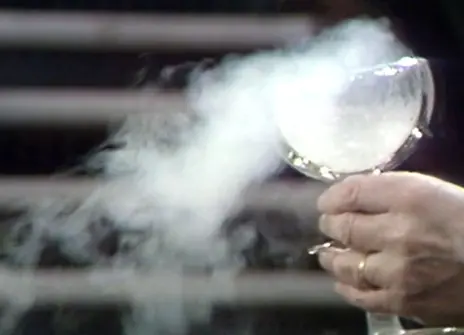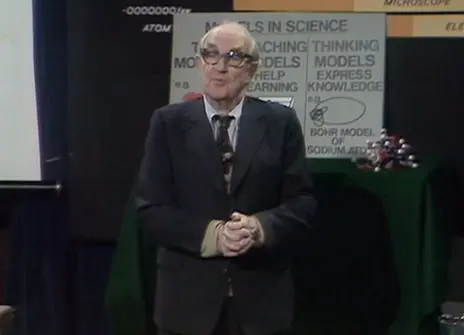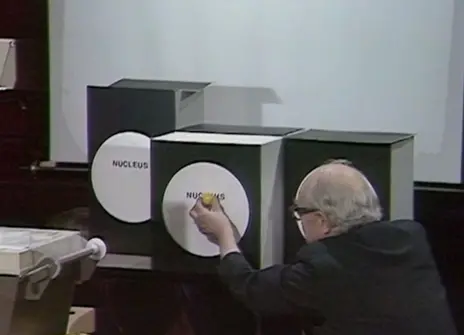Lecture 4 – Atoms that explode
From the 1979 lecture programme:
Most atoms are stable, carbon, hydrogen, oxygen, gold and many others. They stay the same from now to doomsday – except for swapping loose electrons in chemical compounds or in making ions.
But some atoms are radioactive, waiting to explode and hurl out a small 'chip' thus becoming quite a different atom – an atom of a different chemical element. The 'chip' flies out with so much energy that it knocks electrons off hundreds of atoms in the surrounding air — using electrical forces as it flies past. That was how radioactivity was discovered, by the ionization it causes.
And that is how it can sometimes hurt, or cure, your body, by making ions. See a radioactive sample making ions that are driven by an electric field, in a tiny measurable current. Watch three 'mystery experiments' which prepare for radioactive measurements. See Geiger counters respond to three kinds of 'chips' from different radioactive materials – alpha particles (heavy but speedy), beta particles (just high-speed electrons), gamma rays (fastest of all, very short X-rays).
Watch a stream of beta particles pulled into orbit by a magnetic field. The ions formed in wet air by flying 'chips' attract water molecules electrically and thus form starters for water drops in a cloud. A cloud chamber makes use of that and lets us see the track of a 'chip' as a thin line of tiny water drops. See a cloud chamber in action, then look at photographs of special events in it. Those show the clearest evidence for nuclear atoms. The tiny explosions of radioactive atoms seem to happen by pure chance, at random.
But if we have a vast quantity of them the tale of random events smooths out to a steady rate. If we start with a large stockpile, a Geiger counter will show many explosions each minute, then fewer as time goes on — fewer because the stockpile has grown smaller. After a certain time the stockpile has dwindled down to half what we started with, and we call that time the half-life of that radioactive material.
But the remaining half-sized stockpile is, so to speak, as healthy as ever — it shows no signs of old age. It too will dwindle to half in the same half-life from then; and the remainder after that, a quarter of the original stockpile, will dwindle to half in one more half-life; and so on indefinitely.
That law of decay, with a constant half-life, is characteristic of all radioactive materials; and it is essential for people to understand it before they discuss dangers and values of nuclear power. So we shall offer illustrations and show a real example of radioactive decay.
We can now manufacture radioactive isotopes ('twin brothers') of ordinary stable chemical elements. We use them to act as sensitive labels, or tracers, for those elements. See a tracer being used. In preparation for new atomic models in the final lecture we shall show another strange behaviour: a stream of light delivering its energy packaged in 'bullets' of energy – 'photons' as we call them.
That is useful in many practical devices such as an 'electric eye' or a camera's light meter, and it is revolutionary in the world of new physics. Revolutionary because it shows that light has a double nature: behaving as waves, as we shall also show, and (or is it or?) as a stream of compact bullets which can cause more fissions, in a chain reaction. That delivers terrific heat and radioactive products either explosively in a bomb or steadily in a powerstation reactor. You will see models of nuclear changes, fission, chain reactions.
About the 1979 CHRISTMAS LECTURES
From the 1979 lecture programme:
We build our scientific knowledge by doing experiments, by asking questions of Nature and sorting out the answers that Nature gives us. The sorting-out often involves reasoning and imagination; but without trying experiments to see what does happen we should just be guessing in the dark.
The earliest scientists, who helped our ancestors long ago to make a calendar, to navigate, and to measure and build, gathered some knowledge by watching what does happen. Nature was offering experimental knowledge all round them; and they observed and extracted general knowledge and used it. That was knowledge of man-sized things: a hand mirror to reflect rays of sunlight; the star patterns seen at night reduced to a sketch; a seesaw to balance children —leading to weighing machines; a bridge across a stream, leading to knowledge of forces; measurements for a building only a few men high; a survey of a mountain that men could climb.
Such gathering and use of scientific knowledge dates from thousands of years ago, perhaps even a million or so. That was experimental knowledge, though it was sometimes mixed with guessing or even wild imagining. But when men tried to describe the fire of the stars far out of reach, or to imagine outrageously small moving atoms in all matter, they were indeed guessing in the dark about things far above or below the scale of man-sized things.
Some early scientists did make interesting guesses about atoms, yet these were only guesses. These were clever philosophy if you like, but there were no experiments to support them.
Except for clever suggestions, our knowledge of atoms is very young compared with our older scientific knowledge. Some of it is a few centuries old but much of it is only one century old at most. There are two reasons for that late development. First: since atoms are (as we now know) far too small to be seen, all our experimental gathering of knowledge has to be indirect. Although we now know a great deal about atoms, and about the still smaller parts of atoms, we still have to describe them by imaginative pictures which we call models.
Second: even to build such knowledge indirectly, new apparatus had to be developed, such as vacuum pumps and electronic supplies for high voltage. The aid of a vast new technology was needed.
Nowadays when one learns what has been discovered about atoms one has to learn by hearsay, one has to accept the indirect methods and swallow the picturing by imaginative models. Then a keen listener must long for some experimental support or illustrations. That is what these lectures will offer in their 'circus of experiments'. The circus cannot cover all our new knowledge of atoms but it will, we trust, give visitors a feeling of friendly first-hand acquaintance, a contribution of confidence and understanding as well as a delight in seeing experiments.






